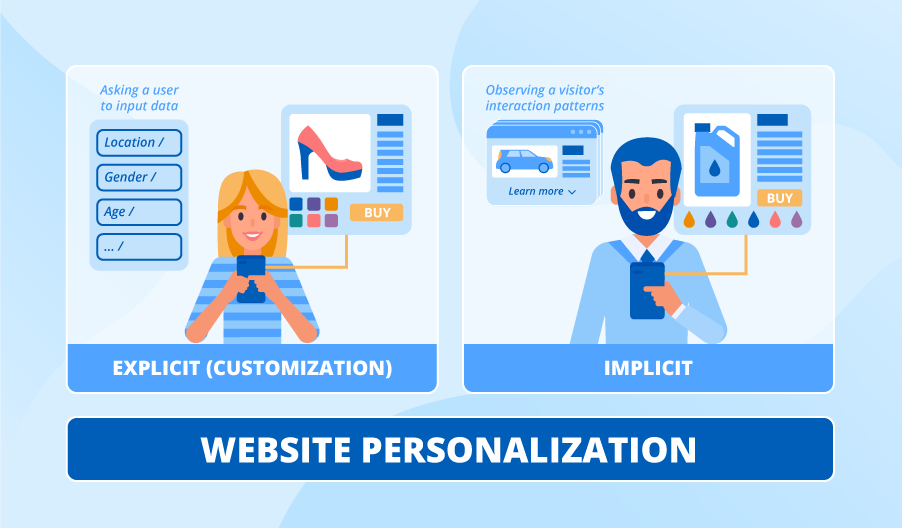How You Can Benefit from Website Personalization
Editor’s Note: Anastasia tells all you need to know about website personalization and explains how it works in favor of your business. If you are interested in introducing personalization on your future or existing website, consider ScienceSoft’s offers of UX design and UI design.
“Stay one step ahead of the customer” – this saying has always been the pillar of quality customer interactions for all physically present businesses. Though just a dozen years ago it was considered unrealistic, today’s online businesses can adhere to this core rule of customer service too. All you need is to introduce automated personalization algorithms to your website.
In this article, I explain the intricacies of the notions ‘customization’ and ‘personalization’, talk about the data used for personalizing experience, as well as explain how exactly website personalization can drive your business results.

Customization and personalization
I see the two terms – customization and personalization – used fully interchangeably often enough to feel the need to clarify the difference between them at the very start.
Website personalization is an umbrella term for the processes or results of tailoring digital experiences to the individual needs and interests of each customer based on collected user data. Your website can obtain this data by either directly asking a user to input it or by silently observing a visitor’s website interaction patterns. In the first case, you are doing explicit personalization (or customization), in the second case – implicit personalization.
This way, customization is only one type of personalization. It appeared way before implicit personalization and continues to be very common online: you may easily recall social media websites like Twitter asking you to specify your location and follow topics of your interest to help you personalize your timeline.
Implicit personalization, however, is a younger and more complex website personalization type, so I’ll talk about it in more detail.
Impressive results of implicit personalization
Because implicit personalization doesn’t rely on the direct input from visitors, the chances of this type of personalization being spot-on can seem to be lower than those of the explicit one’s. Yet, ScienceSoft’s experience shows that powerful implicit personalization mechanisms have the potential to predict the customer’s needs even better than the customer themselves knows them. This can occur with the help of the two types of data that personalization algorithms collect:
- Contextual data - the search query or an ad that led a visitor to your website, the page they landed on, their search on your website. All this creates a ‘context’ that helps your website understand the visitor’s current intents and needs – and guide them straight to what they are searching for.
- Behavioral data - the purchases a customer has already made with your website, the pages they browsed, the type of content they prefer to interact with. With this data, your website can learn the likes and preferences of your clients and tailor their digital experience to incentivize even more engagement.
Benefits of personalization
Directly input, contextual and behavioral data or a combination of all three together shed light on the visitor’s situation – and your website will get the power to make timely and highly relevant personalized incentives. The incentives can take form of pop-up messages, push notifications, information banners and other UI elements.
When set up properly, such personalized incentives can empower your online business and help you reap the following benefits.
Enhanced engagement
If a website can offer customers more of the content they like to interact with, it’s only natural for the user engagement on this website to grow. For instance, if your visitor has seen all the demo videos on your website and then receives a pop-up message or a push notification about a newly published demo, the chance of them clicking and proceeding to the demo is extremely high.
Increased conversion
“Browsing fatigue” is something I have experienced myself and heard others mention when talking about their experience with large online stores. Most likely, your potential customers would be glad to make a purchase with you, but they simply get tired of trying to find the item they’d love. To help your clients out, you can introduce an automatically assembled “Just for you” menu section or dynamic banners and showcases. Both will feature only the items that would be of interest to a customer according to your website’s personalization algorithms.
Improved satisfaction and loyalty
Personalization done right doesn’t recommend customers to buy another inexhaustible kind of a product or service, or interrupt their browsing experience every 5 minutes. At ScienceSoft, UX professionals create an intricate website personalization strategy for each client in order to ensure that all personalization efforts are helpful to users and result in their satisfaction. In the long run, these emotions translate into satisfaction from your services in general and loyalty to your business.
Personalize your clients’ experience to get more loyal customers
As you offer care and assistance to your clients via professionally personalized digital experience, you put direct efforts into making customers stay on your website and be more productive. And since their productiveness is your revenue, it is a win-win deal. Whether you are already set on making website personalization work for you or still have some questions about it, feel free to drop our team a line.

